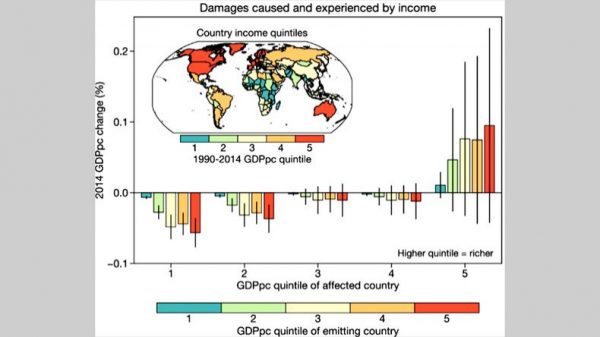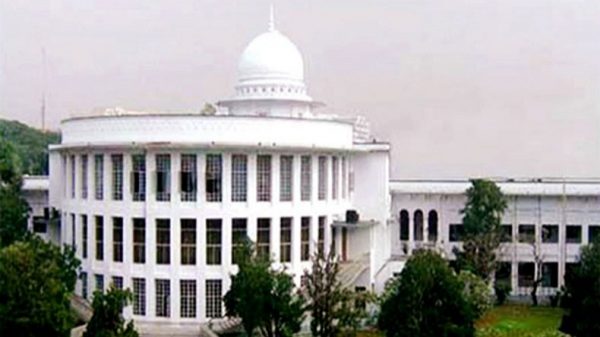Damage that US caused to other countries

Farooque Chowdhury:
With its carbon footprint from 1990 to 2014, the United States caused nearly $2 trillion in damage to other countries, finds a new analysis.
How much ‘aid’, in all forms, has the country provided to other countries? The motive, character, use, implication, and the beneficiary of the so-called aid are not questioned/discussed here.
This is the face of carbon footprint, actually, climate-plunder/expropriation, which is global and impacting the entire humanity and all lives. This is expropriation of climate from the entire humanity; and the humanity is paying with life.
The colossal amount of greenhouse gases released by the United States over the period cited above has led to natural disasters, and economic damage including crop failures in countries, resulting in $1.9 trillion in lost income globally, a report found.
The study by scientists from Dartmouth College and published in the journal Climatic Change on July 12, 2022 (Callahan, CW, Mankin, JS ‘National attribution of historical climate damages’, Climatic Change 172, 40 (2022)).
Northerly countries
THE study finds: the most northerly countries are reaping tangible benefits from climate change, such as longer growing seasons and fewer cold-related deaths; the disproportionate harm befalling poorer and warmer countries is likely even more skewed;
The scientists calculated resulting damages ‘using empirical temperature-growth relationship’ after combining historical climate data with climate models and economic information.
In poor and poorer countries, the impact of climate expropriation is deadly: hundreds die every year, thousands turn destitute and migrants, and millions face uncertainty in terms of livelihood, shelter, health and education.
The study report said:
• When emissions created by international trade are taken into account the United States is placed even more starkly in the lead regarding climate-induced damage, responsible for 18 per cent.
• The damage caused by Russia and China correspondingly decrease by 15 per cent and 9 per cent while those caused by some European countries increase by as much as 20 per cent.
Sue for climate-created harms
THE study findings, as the scientists claim, could provide a basis for poorer countries to sue for climate-related harms.
The study report said:
Previous efforts have been hamstrung by a lack of scientific evidence linking individual carbon emitters to ‘the downstream impacts of warming.’ These countries may be able to take legal action. Such methods of placing blame for climate harms can also be applied to individual corporations, the researchers point out.
Veil of deniability lifted
THE report said: quantifying which nations are culpable for the economic impacts of anthropogenic warming is central to informing climate litigation and restitution claims for climate damages. However, for countries seeking legal redress, the magnitude of economic losses from warming attributable to individual emitters is not known, undermining their standing for climate liability claims. Uncertainties compound at each step from emissions to GHG concentrations, GHG concentrations to global temperature changes, global temperature changes to country-level temperature changes, and country-level temperature changes to economic losses, providing emitters with plausible deniability for damage claims. And, the study lifts the veil of deniability, combining historical data with climate models of varying complexity in an integrated framework to quantify each nation’s culpability for historical temperature-driven income changes in every other country.
The report said: global income changes attributable to the US and China’s emissions over 1990–2014 each exceed $1.8 trillion in both losses and benefits; losses and benefits induced by Russia, India, and Brazil each individually exceed $500 billion. The $6 trillion in cumulative losses attributable to those five countries alone is comparable both to some 14 per cent of annual world GDP and to the economic losses associated with warming the planet to 2 °C rather than 1.5 °C.
Disproportionate contributions: Top 10
IT SAID: Large emitters make disproportionate contributions to climate damages; the top 10 most damaging countries are together responsible for more than 67 per cent of losses and 70 per cent of benefits. The US contributes the most, responsible for 16.5 per cent of losses and 18 per cent of benefits, followed by China, responsible for 15.8 per cent of losses and 16.8 per cent of benefits; every other country individually contributes less than 10 per cent.
Pakistan and Bolivia
THE report said: Small differences in emissions can lead to major differences in attributable damages. For example, Pakistan and Bolivia have similar CO2 emissions, with Pakistan emitting an average of 35 MtC year of CO2 over 1990–2014 and Bolivia emitting an average of 32 MtC year. But that slight difference means that while Pakistan can be tied to $130B in statistically significant losses, Bolivia cannot be tied to any. So, while the result that heavy emitters have caused significant attributable damages may seem obvious, it is not possible to perform a quantitative attribution of precisely how much damage and to whom, nor how confident we can be in such estimates, absent an integrated framework that propagates uncertainty from each step in the analysis.
Gap in responsibility
IT SAID: Under consumption-based accounting, attributable damages increase by 1.5 per cent for the United Styates, increase by 10–20 per cent for some European countries, and decrease by 15 per cent for Russia and 9 per cent for China, expanding the gap in responsibility between the United States and all other countries.
The report said:
• Emissions released early in the twentieth century may have more severe effects because of the longer time period over which the growth effects of such emissions accumulate; at the same time, carbon sinks are stronger at lower emissions levels and the growth effects of warming are milder when baseline temperatures are cooler, so the opposite could be true.
Developing countries
THE report said: Developing countries’ attributable damages and benefits only increase modestly while many countries in Europe experience?>?400% increases, given their large shares of pre-1990 emissions.
Political choice
IT SAID: Damages and thus potential liabilities depend on when emissions accounting begins and on what emissions are considered. These choices are ultimately political. And, the analysis provides a quantitative grounding to inform these political choices.
Warmer and poorer
IT SAID: Countries that lose income are warmer and poorer than the global average, generally located in the tropics. Countries that gain income are cooler and wealthier than the global average, generally located in the midlatitudes. Global warming to date has amplified, and will continue to amplify, this extant pattern of global economic inequality.
And, Our results provide an additional dimension to this globally unequal pattern: The cool, relatively wealthy countries that have gained from anthropogenic warming are also those that (1) have emitted the most and (2) caused the most damage to other countries from their emissions. Nearly all the high-emitting nations in North America and Eurasia are in the top two GDP per capita income quintiles over 1990–2014, though China, India, and Indonesia are exceptions. These top several income quintiles have caused income losses in the poorest two quintiles, while they have caused income gains for themselves that exceed those losses in magnitude.
On the other hand, countries in the lowest income quintile, primarily in Africa and central and south Asia, have caused nearly zero effects on other countries while suffering the greatest disadvantages from the emissions of larger economies. While uncertainty is large for the gains experienced by higher income quintiles, uncertainty is relatively low for damages in the bottom two quintiles. As such, the distributional picture of culpability and equity in climate damages is evident, despite the myriad complexities involved in linking individual nations’ emissions to climate impacts.
The results shown in in the figure use territorial emissions accounting over 1990–2014 as in our [the study] baseline analysis, but many high-income, high-emitting countries have also imported additional emissions through their demand for products from the developing world.
At expense of poorest people
THE report said: These results are consistent with previous work that shows increases in global inequality from historical warming. However, our [the study] findings emphasise that the culpability for warming rests primarily with a handful of major emitters, and that this warming has resulted in the emitters’ enrichment at the expense of the poorest people in the world. Our work [the study] shows that anthropogenic warming constitutes a substantial international wealth transfer from the poor to the wealthy.
High-income countries harmed low-income countries
THE study report said: GHG emissions from high-emitting countries have caused substantial economic losses in low-income, tropical parts of the world and economic gains in high-income, midlatitude regions. Critically, these economic changes are attributable to the largest emitters despite the substantial uncertainties at each step in the causal chain from emissions to impact. Our results are robust despite the wide range of carbon cycle parameters and climate sensitivities, global-to-local forcing strengths, and temperature-growth specifications we test.
• These results have two key implications. Firstly, they illustrate that physical climate uncertainty may constitute the dominant source of uncertainty in losses in tropical countries that are attributable to major emitters. While uncertainty in the relationship between the climate and economy is the dominant uncertainty in global losses from warming, our results demonstrate that this does not hold at the country level. In the low-income tropical countries that are most vulnerable to warming, internal climate variability and differences in model structure can produce a wide range in damages attributable to major emitters like the US. Scientific efforts to narrow uncertainty in regional climate change may therefore pay large dividends for countries seeking legal recourse for climate damages.
• Secondly, the actions of specific emitters can be tied to the downstream monetary implications of climate change. Emerging discussions about climate liability have been limited to date by a lack of scientific evidence supporting causal linkages between individual countries’ emissions and the consequent local impacts.
The scientists claim their ‘framework shows that such linkages can be quantified using state-of-the-art climate models and empirical approaches and that we can process-trace exactly who has caused economic losses from their emissions, and how much.’
Firms and farmers
THE report said: While previous studies have illustrated the economic harms of global warming, our work shows that these harms can be assigned to individual emitters in a way that rigorously accounts for the compounding uncertainties at each step of the causal chain from emissions to local impact. Finally, it is worth noting that our approach can be generalized to other actors, such as individual firms, or to other harms, such as the economic losses suffered by farmers due to extreme heat. These results therefore contribute to resolving a key barrier to climate liability efforts and advance these critical emerging discussions.
The findings, etc of the above mentioned study are significant. The study findings show that climate movement, poor peasants and agricultural labor movement, working class movement, rights movement, anti-imperialism movement, these are parts of democratic movement, even, rich farmers’ movement, have ground to raise climate related demands; and demands are political. The politics of the exploited classes have no scope to ignore the issue of climate, to be exact, climate expropriation.
The issue is also found in many other studies. A 2012 study (Wei T, Yang S, Moore JC, Shi P, Cui X, Duan Q, Xu B, Dai Y, Yuan W, Wei X et al (2012), Developed and developing world responsibilities for historical climate change and CO2 mitigation, Proceedings of the National Academy of Sciences of the United States of America, 109 (32)) said:
• Negotiations on emission reduction among countries are increasingly fraught with difficulty, partly because of arguments about the responsibility for the ongoing temperature rise. Simulations with two earth-system models demonstrate that developed countries had contributed about 60-80%, developing countries about 20-40%, to the global temperature rise, upper ocean warming, and sea-ice reduction by 2005.
Seven years later, another study (Diffenbaugh NS, Burke M (2019), Global warming has increased global economic inequality, Proc Natl Acad Sci, 116(20)) said: Understanding the causes of economic inequality is critical for achieving equitable economic development.
To investigate whether global warming has affected the recent evolution of inequality, the study combined counterfactual historical temperature trajectories from a suite of global climate models with extensively replicated empirical evidence of the relationship between historical temperature fluctuations and economic growth. Together, these allowed the scientists to generate probabilistic country-level estimates of the influence of anthropogenic climate forcing on historical economic output.
The study found: Very high likelihood that anthropogenic climate forcing has increased economic inequality between countries.
As example, the study cited the following facts: Per capita GDP has been reduced 17-31 per cent at the poorest four deciles of the population-weighted country-level per capita GDP distribution, yielding a ratio between the top and bottom deciles that is 25 per cent larger than in a world without global warming. As a result, although between-country inequality has decreased over the past half century, there is ~90 per cent likelihood that global warming has slowed that decrease. The primary driver is the parabolic relationship between temperature and economic growth, with warming increasing growth in cool countries and decreasing growth in warm countries. Although there is uncertainty in whether historical warming has benefited some temperate, rich countries, for most poor countries there is >90 per cent likelihood that per capita GDP is lower today than if global warming had not occurred. Thus, our results show that, in addition to not sharing equally in the direct benefits of fossil fuel use, many poor countries have been significantly harmed by the warming arising from wealthy countries’ energy consumption.
This year, a study (Beusch, L, Nauels, A, Gudmundsson, L et al, Responsibility of major emitters for country-level warming and extreme hot years, Commun Earth Environ 3, 7, January 6, 2022) quantified contributions of the five largest emitters — China, the United States, EU-27, India, Russia — to project 2030 country-level warming and extreme hot years with respect to pre-industrial climate.
The study found: Under current pledges, their cumulated 1991–2030 emissions are expected to result in extreme hot years every second year by 2030 in twice as many countries (92 per cent) as without their influence (46 per cent). If all world nations shared the same fossil CO2 per capita emissions as projected for the United States from 2016–2030, global warming in 2030 would be 0.4°C higher than under actual current pledges, and 75 per cent of all countries would exceed 2°C of regional warming instead of 11 per cent.
The study report said:
• The United States is the largest per capita emitter, followed by Russia, China, EU-27, and finally India.
• The top five emitters — China, US, EU-27, India, and Russia — are playing a major role in driving global and regional warming and are increasing the probability for extreme hot years, both since the first IPCC report of 1990 and even only since the Paris Agreement of 2015. In the context of their current Paris Agreement emissions pledges, the United States, Russia, China, and EU-27 would experience even more severe warming by 2030 if the whole world were to follow the same per capita fossil CO2 emissions as them.
There are, according to the report, ‘small countries with large per capita emissions, such as Switzerland and similar-size countries’ also. These countries are, the report said, to ‘pursue more stringent mitigation efforts’.
There’s no scope to confine the climate crisis issue within the narrow discussion of climate-only, if the findings cited above are considered from people’s, especially the poor, working people’s perspective. The issue is not also to be handled by NGOS only. Rather, the issue should be handled by political organizations/parties, as this issue (i) involves capitals, (ii) capitals’ conflict with people, (iii) is political, and (iv) this involves political decision. These make the issue of climate one of the major and immediate tasks of political organizations, especially, the political organizations of people, especially the poor.
The climate-reality is a reflection of climate plunder. Capitals involved in this climate business, and, to be specific, the world capitalist system is just expropriation and plunder of the climate. This is in addition to appropriation of surplus labor the world around. In the case of climate, it is not only the labor chained by capital that pays for capitals’ climate plunder, but the entire population, parts of the population do not always sale their labor power to capital, makes the payment. Even, deterioration of climate harms labor productivity, an issue of concern to related capitals. The findings of the study also help identify contradictions related to climate and the world capitalist system. There are people on one pole, and climate-expropriating capital on another. Considering the issues, the new study cited above is significant as climate expropriation by capital has turned out as crime against humanity.
Farooque Chowdhury writes from Dhaka, Bangladesh.























Leave a Reply